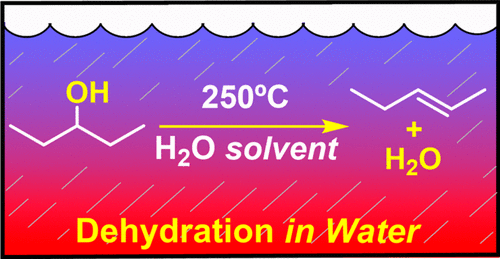当前位置:
X-MOL 学术
›
ACS Earth Space Chem.
›
论文详情
Our official English website, www.x-mol.net, welcomes your
feedback! (Note: you will need to create a separate account there.)
Kinetics and Mechanisms of Dehydration of Secondary Alcohols Under Hydrothermal Conditions
ACS Earth and Space Chemistry ( IF 2.9 ) Pub Date : 2018-06-11 00:00:00 , DOI: 10.1021/acsearthspacechem.8b00030 Christiana Bockisch 1 , Edward D. Lorance 2 , Hilairy E. Hartnett 1, 3 , Everett L. Shock 1, 3 , Ian R. Gould 1
ACS Earth and Space Chemistry ( IF 2.9 ) Pub Date : 2018-06-11 00:00:00 , DOI: 10.1021/acsearthspacechem.8b00030 Christiana Bockisch 1 , Edward D. Lorance 2 , Hilairy E. Hartnett 1, 3 , Everett L. Shock 1, 3 , Ian R. Gould 1
Affiliation

|
Alcohol dehydration by elimination of water is central to a series of functional group interconversions that have been proposed as a reaction pathway that connects hydrocarbons and carboxylic acids under geochemically relevant hydrothermal conditions such as in sedimentary basins. Hydrothermal dehydration of alcohols is an example of an organic reaction that is quite different from the corresponding chemistry under ambient laboratory conditions. In hydrothermal dehydration, water acts as the solvent and provides the catalyst, and no additional reagents are required. This stands in contrast to the same reaction at ambient conditions, where concentrated strong acids are required. Hydrothermal dehydration is thus of potential interest in the context of green chemistry. We investigated the mechanism of hydrothermal alcohol dehydration for a series of secondary alcohols using studies of kinetics and stereoelectronic effects to establish reaction mechanisms. The E1 elimination mechanism dominates over the corresponding E2 mechanism, with the E2 mechanism being competitive with E1 only for the most favorable stereoelectronically restricted alcohols included in the present study. These results are relevant to understanding the kinetics and product distributions of alcohol dehydration reactions in natural geologic systems and can guide the development of organic chemical reactions that mimic geologic organic reactions under laboratory green chemistry conditions.
中文翻译:

水热条件下仲醇脱水的动力学及机理
通过消除水来进行酒精脱水是一系列官能团相互转化的关键,这些官能团相互转化已被提出作为在地球化学相关的水热条件下(例如在沉积盆地中)连接碳氢化合物和羧酸的反应途径。醇的水热脱水是有机反应的一个例子,与环境实验室条件下的相应化学反应完全不同。在水热脱水中,水充当溶剂并提供催化剂,不需要其他试剂。这与在室温条件下需要浓缩强酸的相同反应形成对比。因此,在绿色化学的背景下,水热脱水可能引起人们的兴趣。我们使用动力学和立体电子效应研究建立反应机理,研究了一系列仲醇的水热醇脱水机理。E1消除机制在相应的E2机制上占主导地位,而E2机制仅对本研究中所包括的最有利的立体电子限制醇与E1竞争。这些结果与了解自然地质系统中醇类脱水反应的动力学和产物分布有关,并可以指导模仿实验室绿色化学条件下的地质有机反应的有机化学反应的发展。E1消除机制在相应的E2机制上占主导地位,而E2机制仅对本研究中所包括的最有利的立体电子限制醇与E1竞争。这些结果与了解自然地质系统中醇类脱水反应的动力学和产物分布有关,并且可以指导在实验室绿色化学条件下模拟地质有机反应的有机化学反应的发展。E1消除机制在相应的E2机制上占主导地位,而E2机制仅对本研究中所包括的最有利的立体电子限制醇与E1竞争。这些结果与了解自然地质系统中醇类脱水反应的动力学和产物分布有关,并且可以指导在实验室绿色化学条件下模拟地质有机反应的有机化学反应的发展。
更新日期:2018-06-11
中文翻译:

水热条件下仲醇脱水的动力学及机理
通过消除水来进行酒精脱水是一系列官能团相互转化的关键,这些官能团相互转化已被提出作为在地球化学相关的水热条件下(例如在沉积盆地中)连接碳氢化合物和羧酸的反应途径。醇的水热脱水是有机反应的一个例子,与环境实验室条件下的相应化学反应完全不同。在水热脱水中,水充当溶剂并提供催化剂,不需要其他试剂。这与在室温条件下需要浓缩强酸的相同反应形成对比。因此,在绿色化学的背景下,水热脱水可能引起人们的兴趣。我们使用动力学和立体电子效应研究建立反应机理,研究了一系列仲醇的水热醇脱水机理。E1消除机制在相应的E2机制上占主导地位,而E2机制仅对本研究中所包括的最有利的立体电子限制醇与E1竞争。这些结果与了解自然地质系统中醇类脱水反应的动力学和产物分布有关,并可以指导模仿实验室绿色化学条件下的地质有机反应的有机化学反应的发展。E1消除机制在相应的E2机制上占主导地位,而E2机制仅对本研究中所包括的最有利的立体电子限制醇与E1竞争。这些结果与了解自然地质系统中醇类脱水反应的动力学和产物分布有关,并且可以指导在实验室绿色化学条件下模拟地质有机反应的有机化学反应的发展。E1消除机制在相应的E2机制上占主导地位,而E2机制仅对本研究中所包括的最有利的立体电子限制醇与E1竞争。这些结果与了解自然地质系统中醇类脱水反应的动力学和产物分布有关,并且可以指导在实验室绿色化学条件下模拟地质有机反应的有机化学反应的发展。











































 京公网安备 11010802027423号
京公网安备 11010802027423号